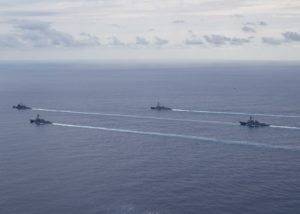The Navy’s 2nd Fleet (C2F) temporarily set up an expeditionary Maritime Operations Center (MOC) in Keflavik, Iceland, while a group of ships operates in the North Atlantic, the service said Tuesday.
The service explained the MOC will provide the U.S. Naval Forces Europe commander with an additional ability to lead forces from a forward-operating location.

This MOC is made of about 30 members of 2nd Fleet staff, can command and control forces, provide basic indicators and warnings for situational awareness, and can issue orders while maintaining reach-back capability to C2F headquarters in Norfolk, Va., the Navy said.
The Navy noted the expeditionary MOC concept is “scalable and temporary in nature” and while this MOC is operating out of Iceland, “there is no predetermined or permanent operating location in the European theater.”
The 2nd Fleet MOC is specifically executing command and control of ships assigned to the recently deployed Surface Action Group (SAG), which is made of the Ticonderoga-class guided-missile cruiser USS Normandy (CG-60) and Arleigh Burke-class guided-missile destroyers USS Lassen (DDG-82), USS Forrest Sherman (DDG-98), and USS Farragut (DDG-99), as well as embarked aircraft from Helicopter Maritime Strike Squadron (HSM) 72.
These ships normally are part of the Harry S. Truman Carrier Strike Group, based out of Norfolk, Va. However, the SAG formed earlier this month after the Navy announced an “emergent maintenance requirement for an electrical issue” aboard the USS Harry S. Truman (CVN-75) in August.
The Navy said the carrier’s repairs are proceeding and it is making all efforts to deploy the carrier and its air wing as soon as possible. In the meantime, the SAG is working to support naval operations.
Specifically, in the Atlantic Ocean, the SAG is operating “in support of naval operations to maintain maritime stability and security, deter aggression, and defend U.S., allied, and partner interests.”
The 2nd Fleet’s temporary MOC operations are the second time the newly reestablished fleet has operated at a forward location. It first proved its expeditionary capability by command and control of Baltic Operations (BALTOPS) exercises in June 2019, when most of its staff embarked on the USS Mount Whitney (LCC-20) (Defense Daily, June 24).
“I welcome C2F back to the European theater for the second time this year. The additive capacity that 2nd Fleet brings to the European theater when operating forward alongside U.S. 6th Fleet (C6F) contributes to the overall success of our naval forces’ ability to address challenges and threats to safety and security in the maritime domain,” Adm. James Foggo III, commander of Naval Forces Europe and Africa, said in a statement.
“Operating out of Iceland reinforces our partnership while allowing us to practice operating in an expeditionary manner and test our ability to surge forward,” Vice Adm. Andrew Lewis, commander, U.S. 2nd Fleet, added.
Capt. Chris Slattery, director of the C2F expeditionary MOC, underscored successful operations in the Arctic require practice. “We will take the lessons learned from this deployment to further refine the expeditionary MOC concept for future operations in the North Atlantic and Arctic regions,” he said.
These operations fit into the Navy’s updated Arctic Strategy, released in June. That document noted the Defense Department will enhance maritime surveillance in the Greenland-Iceland-U.K.-Norwegian gap and conduct regular exercises and deployments in the Arctic region with allies and partners (Defense Daily, June 11).
The 2nd Fleet declared it achieved initial operational capability in May (Defense Daily, May 30).
The fleet was disestablished in 2011 with most of its assets, personnel, and responsibility transferred to U.S. Fleet Forces. Then, in May 2018, the former Chief of Naval Operations Adm. John Richardson announced it would return on a recommendation from the Secretary of the Navy’s Strategic Readiness Review. 2nd Fleet was then officially reestablished last August (Defense Daily, Aug. 24, 2018)